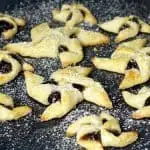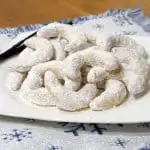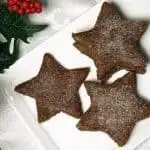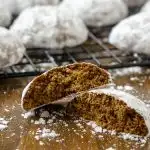Zimtsterne are German star-shaped cookies that are a classic addition to a festive cookie plate. They are naturally gluten free and relatively easy to make, with only a few ingredients. They are delicious, whether eaten in the Christmas season or not.
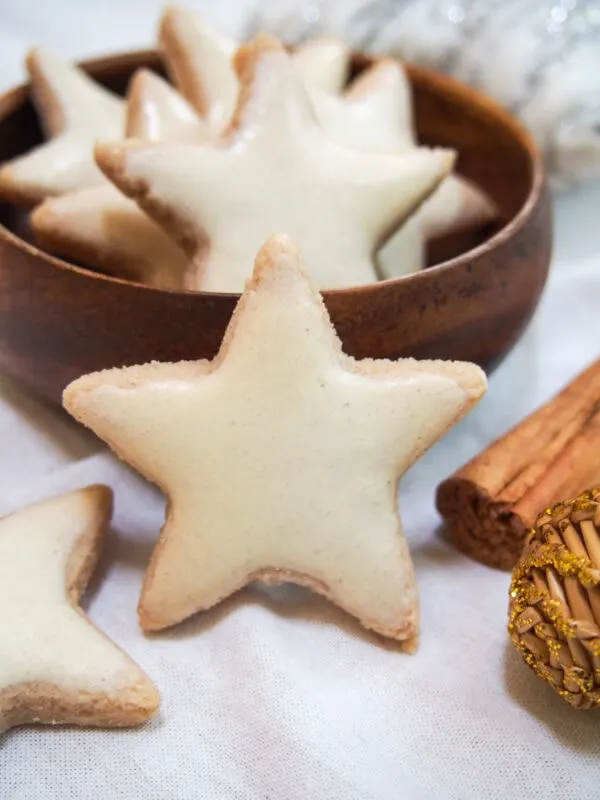
Germany has a strong tradition of baking cookies during the Christmas season that goes back centuries.
The term Weihnachtsplätzchen translates as Christmas cookies, but it is really much broader. Alongside a number of traditional cookies, the term generally includes the cake-like Stollen.
Some are also not only a Christian tradition, like these star cookies.
Origins of zimtsterne
The German Weihnachtsplätzchen tradition has been traced back to Medieval times, when the cookies were originally made by monks.
The origins of these particular star cookies is unclear, but the first written mention of them dates back to the 16th century.
At this time, cinnamon was a rare and expensive ingredient. It was really only used by royalty and the ruling classes. Sugar was relatively expensive and almonds were also imported, so cookies like these were only enjoyed by the very rich.
In fact, the cookie making tradition didn’t become a household activity until the 19th century.
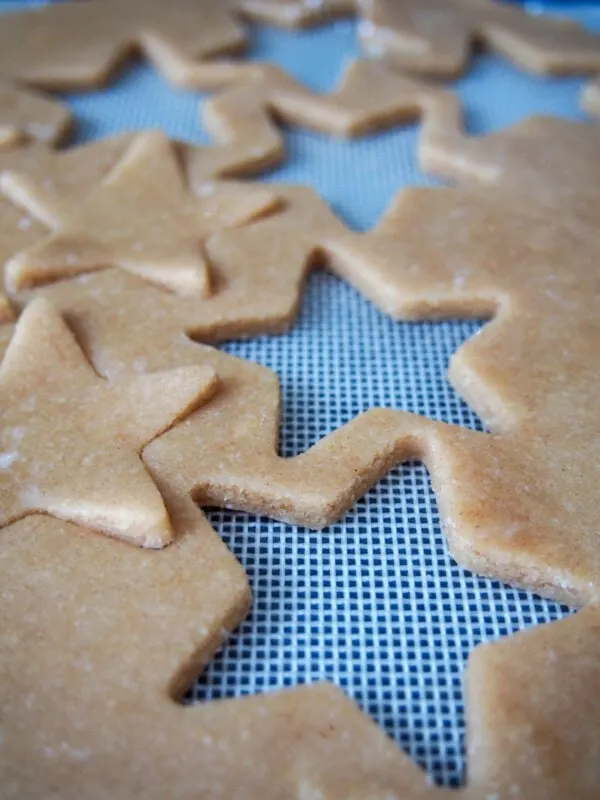
Zimtsterne (directly translated ‘cinnamon stars’) are one of a number of traditional cookies made during Advent (the four weeks preceding Christmas) and for Christmas, along with Lebkuchen, Vanillekipferl, Pfeffernüsse, Spritz cookies, Ingwerplätzchen, Springerle, and various others.
They are also known as Erstersternen (first stars) and eaten by German Jews as part of the first meal after the Yom Kippur fast.
Some people make these at home, while others will buy them ready-made early in the Advent period, so they have them ready to share with any visitors during the Christmas season.
These cookies are great for keeping and sharing over a longer period of time, as they will last for around two weeks, gradually becoming slightly chewier.
As far as shape, you’ll often find these in a six-pointed star shape, but you can use whichever shape star cutter you have.
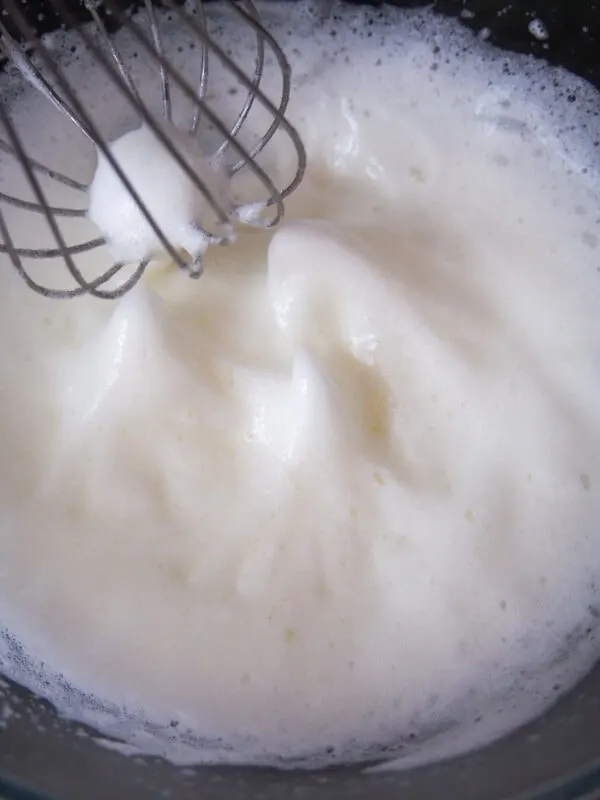
Soft peaks in the egg whites
Ingredients in cinnamon stars
The core, basic ingredients in these cookies are egg white, nuts, and cinnamon. Some will add a little extra flavoring such as vanilla and/or lemon or orange zest.
In general, the nuts are almonds, but the cookies can also be partly (or fully) made with hazelnuts.
If these ingredients sound a bit like French macarons, then you would be right. These two cookies do have a certain amount of similarities, but also some differences.
First, the base cookie mixture is thicker and you roll it rather than pipe it. Then secondly, these Zimtsterne have a distinctive topping.
On first glance, you might think you add a layer of frosting to these cookies, but in fact, the topping is added before baking.
It is a thin layer of meringue that gently hardens as it bakes, but keeps its pale color since you cook the cookies at a low heat and only for a short time.

Should I use almond flour or almond meal?
Many recipes say you should only make these with almond meal, and not almond flour. Almond meal is a bit coarser and made from almonds with their skins on. It also has more of the oil retained. Almond flour, meanwhile, is finer and made from blanched almonds.
Made with almond meal, these have a darker color and coarser texture, but that is what many people associate with these cookies. You will also often find them made a bit thicker than I have made them here (which fits with the coarser texture).
While it may be less traditional, these definitely work just as well with almond flour, which is often easier to find. They are a little smoother, but certainly just as delicious.
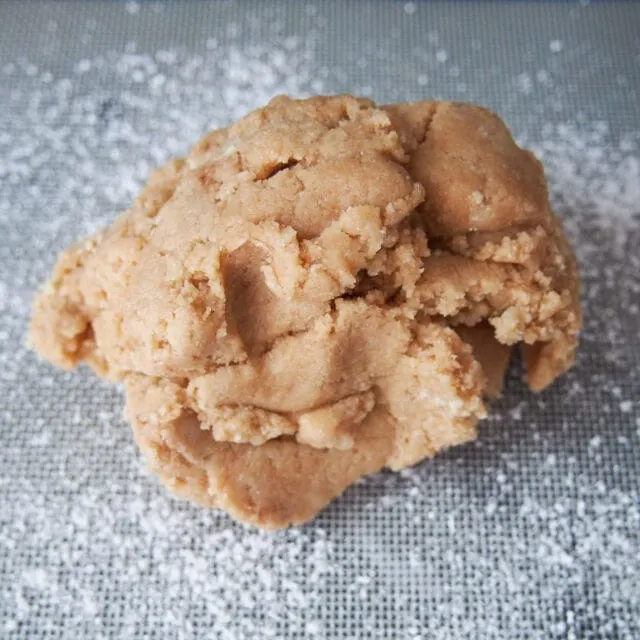
This is what the dough looks like when made with almond flour
Tips for making German zimtsterne cookies
Some people choose to make the topping separately from the rest of the meringue used in the cookie dough, but it is just as easy to simply scoop some of the meringue mixture to the side before you add the nuts and cinnamon. This is particularly helpful if you don’t want to make a huge batch.
Since the base for these cookies is a kind of meringue, even with the nut flour in there, the dough can be sticky. This can make it a little awkward to work with, but there are a few things that make it easier.
First of all, chill the dough before you roll it, to make it more firm. This makes it quite a bit easier to work with.
Secondly, roll the dough either on waxed paper or a silicone baking mat. This makes the cookies a lot easier to pick up. And, worst case, you can lift the paper/mat up to help unstick them. Also, if you dust the paper or mat with powdered sugar, it helps to make the dough less likely to stick.
You can also roll the dough with an additional layer of wax paper or parchment on top, to stop the rolling pin sticking to it. Having tried both with and without, I found this helpful for initial rolling but not really needed for subsequent rolling out of the scraps.
As mentioned, these cookies are often made on the thicker side, but it is really up to you how thick or thin you make them.

No matter how thick you make the cookies, one thing you don’t want to skip, is the meringue topping.
There are various ways you can add the topping to the cookies. First, have all the cookies ready on a lined baking sheet, so all you do after topping is put the baking sheet in the oven.
You can use a cocktail stick (toothpick), small brush, or back of teaspoon to spread the topping over the cookies. Start by adding a small blob to the middle then spread it out towards the tips of the stars.
Once you have coated all of the cookies, bake them in a relatively low oven until the top looks dry but the meringue is still white. The cookies may still be a little soft, but they will firm up as they cool.
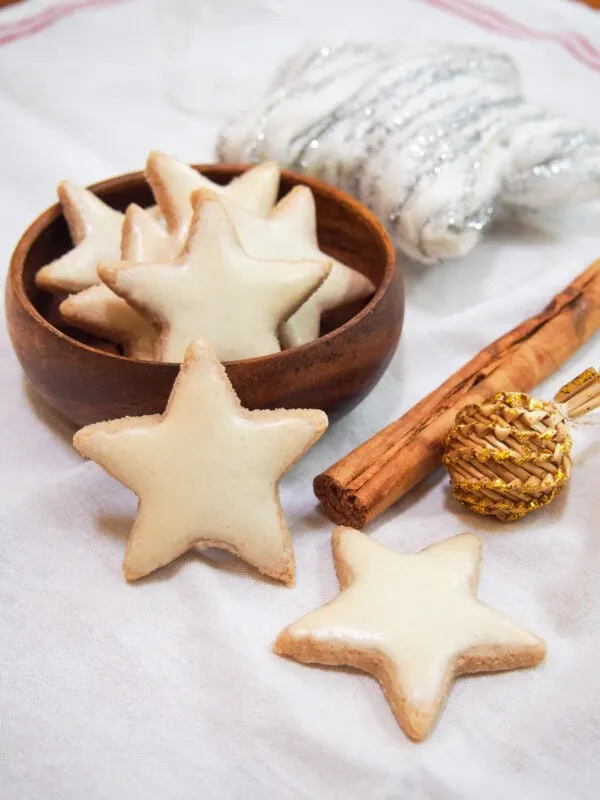
These cookies have a delicious gently spiced flavor, are nicely chewy and sweet, not to mention a pretty addition to any cookie plate.
Naturally gluten free and relatively easy, there are so many reasons to enjoy this festive treat!
Zimtsterne (German Cinnamon Stars)
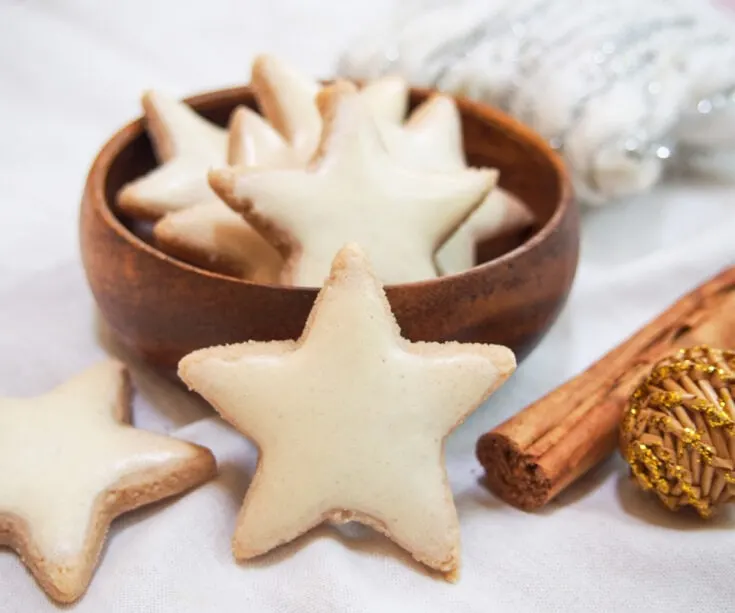
Zimtsterne are German cinnamon flavored, star-shaped cookies. They are naturally gluten free and easy to make, taking only a few ingredients.
Yield listed is approximate - actual yield will depend on thickness of rolled dough and size of cookie cutter
Ingredients
- 2 egg whites (at room temperature)
- 1 1/4 cups (138g) confectioner's sugar (powdered sugar)
- 2 cups (200g) almond meal (can use some/all hazelnut meal or almond flour but will be smoother in texture)
- 1 tsp cinnamon (or 1 1/2 tsp for slightly stronger flavor)
- 1 pinch salt
Instructions
- Beat the egg whites for a few minutes until they reach soft peak consistency.
- Add the confectioner's sugar and continue to beat/whisk until the mixture is well combined and glossy. Remove 1/4 cup of the mixture for the topping and set it aside in a bowl.
- Add the almond meal/flour, cinnamon, and salt. Mix everything together so that it is well combined. Bring the dough together, wrap it and refrigerate for around 30 minutes to an hour.
- Preheat the oven to 300F and prepare one or two baking sheets with parchment or silicone baking mats.
- Place a silicone baking mat on a work surface or cut a piece of waxed paper to line an area. Sprinkle the mat/paper with a little confectioner's sugar then place the chilled dough on top, slightly flattening the dough with your hand.
- You can either cover the dough with a piece of waxed/parchment paper or just dust the rolling pin with additional sugar. Roll out the dough to roughly 1/3 to 0.4in (3/4 - 1cm) thick. (If using almond meal, the cookies should be rolled on the thicker side. If using almond flour, they can be rolled a bit thinner.) Use a star-shaped cutter to cut out cookies and carefully transfer them to the prepared baking sheets. (To help stop the cutter sticking, try dipping the cutter in confectioner's sugar now and then, and you may need to wash it in warm water now and then as well.)
- Once you have cut cookies from the dough, bring the extra dough into a ball and roll out again to cut additional cookies.
- Using a teaspoon, place a little of the reserved meringue topping in the middle of one of the cookies and either use the back of the spoon, a cocktail stick (toothpick), or a small brush to help spread the topping to the edges of the cookie, forming a thin layer. (Try to avoid it dripping down the sides.) Repeat with the rest of the cookies.
- Bake the cookies for approximately 12 - 15 minutes, until the top of the cookie looks dry but the meringue topping is still white rather than becoming yellow/brown. Remove the cookies from the oven and allow to cool completely on the baking sheet. (They may be slightly soft initially.)
- Cookies will keep, stored in an airtight container at room temperature, for approximately 2 weeks, becoming slightly more chewy and softer over time.
Recommended Products
As an Amazon Associate and member of other affiliate programs, We earn from qualifying purchases.
Nutrition Information:
Yield:
20Serving Size:
2 cookiesAmount Per Serving: Calories: 94
If you liked this recipe, here are some similar dishes you may enjoy!

Caroline lived and traveled various places before settling in Cambridge, MA. She still fits in some travel with her family, but often settles for traveling through food instead. She shares her recipes at CarolinesCooking.com, where there’s plenty of international inspiration using seasonal ingredients, as well as creative recipes for all to enjoy. Caroline is originally from Scotland, where she grew up hiking and skiing, both things she still loves to do when her two young boys give her a chance. You can follow along with her cooking adventures on Facebook, Instagram, Twitter, and Pinterest.



